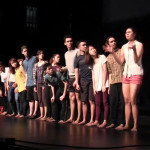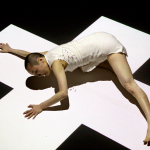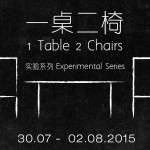“A playful take on the Red Terror”
Reviewer: Sam Kee
Performance: 4 September 2015
In the heat of our election rallies, candidates are addressing their audience in as many languages and dialects as they could manage to garner favour. It is thus delightful to see multilingualism being exploited for a greater purpose in theatre, as in Wang Chong’s Revolutionary Model Play 2.0.
His characters’ most intimate and personal opinions are performed in their mother tongues, intensifying their emotions. In the last scene, when Jiang Qing (played by Kathy Han) speaks to American biographer, Roxane Witke (played by Rebeka Sangeetha Dorai), she pours her heart out in Korean. To a Singaporean audience, the foreign language is likely to disorientate them. Since the audience is unable to comprehend what the characters are saying (unless we read the surtitles fast enough), we can only rely on the rise and fall of their voices. The rich intonations of the spoken language effectively portray their feelings. This approach highlights the meaninglessness of spoken words. It seems to signify that we, as outsiders, are not meant to understand what they are saying. Even if they were speaking in English, we can never fully comprehend their decisions under extreme political circumstances. It is like an intimate secret the character is sharing.
Wang Chong’s use of stage effects is refreshing. He managed to make it rain relentlessly for an hour on stage! A clever mix of rice and water results in a convincing wet and gruelling atmosphere, visually and aurally. Red calligraphy papers soaking in the puddles and water bombs of red colouring quickly dye the stage red, aptly portraying the intensifying terror of the Cultural Revolution.
We also witness one of Wang Chong’s signature theatrical elements – the juxtaposition of live feed and the actual play that is unfolding on stage simultaneously. At the height of betrayal of friendships and purging, four video cameras provide four angles to the exchange between Jiang Qing and her old friends onstage. It allows us to see the different facets of this historical figure through her complicated past.
When we enter the theatre, we are greeted by sampler snippets of the original model plays, projected onto a collage of Chinese newsprints. As the play comes to an end, the ‘Young Champions’ change out of their uniform and tear down the newsprints. With red blindfolds over their eyes, they rotate to face the audience. The protagonist Yu, acting as a stand-in for the actual playwright, joins in the mass, adding to the performance his role as the documenter. This seems to signify the end of the Cultural Revolution but there is a lingering thought that the impact will be felt through the following generations.
At one point, the play draws a parallel between Jiang Qing and Nora in A Doll’s House. Nevertheless, it is beautiful that, despite the plethora of insights provided during the play, Jiang Qing remains a charming enigma. She is only human after all.
Do you have an opinion or comment about this post? Email us at info@centre42.sg.
ABOUT THE PRODUCTION
THE REVOLUTIONARY MODEL PLAY 2.0 by BY Wang Chong & Théatre du Rêve Expérimental, LASALLE College of the Arts
2 – 4 August 2015,
The Singapore Airlines Theatre, LASALLE
ABOUT THE REVIEWER
Sam Kee is currently helming the literary and visual arts section at artsrepublic.sg while putting her major in Mathematics to good use at an educational publishing house.





